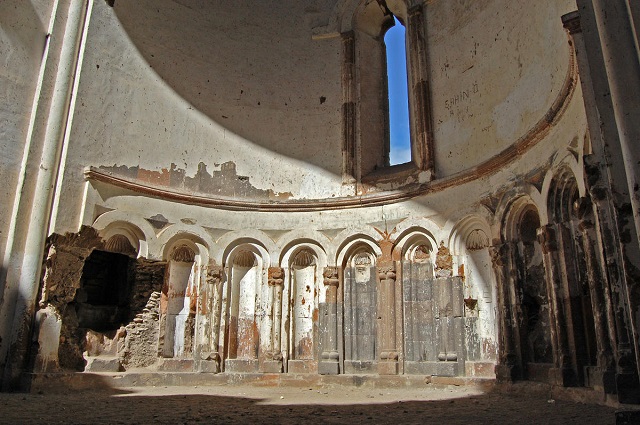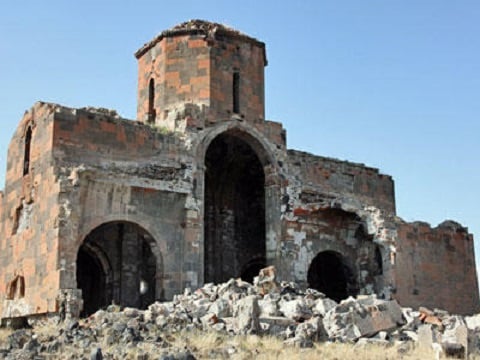The Armenian Weekly. The human loss of the Armenian Genocide remains a painful void in the lives of all `. It is a crime where the victim’s family knows the perpetrator but justice has been denied. Our ancestors lived on the Armenian Highlands for over 4,000 years with nearly half of that time as a Christian people. When you are invested in the neighborhood that long, the roots run deep. The Genocide nearly destroyed the earthly human presence of our people and erased the vibrant civilization of Western Armenia.
What the Turks could not erase was the truth of history. There were other survivors called Mren, Akhtamar and Ani. Centuries of artistic contributions and architectural treasures became the gift of our ancestors. The sustainability of a people is dependent on succession from one generation to the next, its language, cultural contributions and traditions. That evolution defines the history of a people. The Armenians are no exception.
Many Armenians believe, painfully, that our history in Western Armenia ended with the Genocide. The visible absence of populated villages may be the most obvious result, but our civilization ran deeper. Fortunately, our ancestors were builders, an artistic people that left us examples from which we can learn, admire and protect. That job has become very difficult indeed with our physical absence and political environment, but not impossible. It is inspiring to look at it in the context of our history; resilience and survival are part of who we are. The odds have been difficult for centuries, yet we endure. Why should our view today towards the churches and monuments left in the Highlands be any different? We gratefully accept the gift as a part of our inheritance. We embrace the language, the food, our traditions and each other. We reach out to help one another in Syria, Armenia and Lebanon. It is a beautiful attribute of who we are. We have something left to us that also needs help. It is inanimate and reflects the cultural brilliance of what we believe but has fallen on hard times. We have lost many of these examples of our civilization, but we must focus on the survivors.
The churches and monuments in the Highlands evoke many divergent emotions from Armenians today. I have spoken to hundreds of people on this subject and the range of views is significant. Most Armenians embrace them with pride and respect, but there is also significant sadness and anger. The latter two limit any contemporary action. It is difficult for many to overcome the grief of seeing our abandoned churches knowing that the faithful were murdered and deported. Others feel a sense of hopelessness. The Turks control the region and many of these treasures such as Ani or Mren have or still are in military zones, thus limiting access. The responses have been, “What can we do with the Turks controlling the area?” This is a valid point and certainly contributes to the complexity of the task. A final challenge is education. As the generations continue, the working knowledge or even awareness of what exists is limited. This is a constant threat for a dispersed people. Education is critical. Without knowledge, there is little one can do to contribute to a solution.
Read also
Fortunately, our resilient people have developed a new generation of human resources who are committed to making a difference. Their dedication should inspire all of us. Recently, Matthew Karanian published a superb educational resource on the region called, “The Armenian Highland.” It captures the visual essence of these monuments and offers geographic education for the audience. It is enticing to read and provides the reader with complete perspective on what we call our lost lands. In my view, it should be on every coffee table in Armenian homes. Matthew’s photojournalism contributions are admirable. Addressing the issue of sustainable knowledge has been his passion. For many years, Armen Aroyan from California led countless tours to these historic lands that offered many Armenians an opportunity to acquaint themselves with their families’ villages and gain a further emotional connection. We have among us dedicated resources, such as scholar Dr. Khatchig Mouradian and genealogist George Aghjayan, who have opened many doors with “hidden Armenians,” village histories and visibility of churches and monuments in the Highlands. Khatchig writes and lectures about this frequently in his work based out of Columbia University. George has sponsored several genealogy workshops across the United States to increase education and identity among diaspora Armenians.
The subject of “hidden Armenians” in the Highlands has been more visible and quite intriguing over the last 10 years. An incredible example of resiliency, these descendants of the Genocide have secretly retained their ethnic identity and many at great personal risk are seeking to reclaim their heritage. Raffi Bedrosyan is an example of someone who has worked tirelessly for the restoration of the Surp Giragos church in Diyarbekir and has been very active in the “hidden Armenian” community. These are a few examples of Armenian life in the Highlands. More must be done, but progress is a reality. You can be the beneficiary of their devotion and add value to the challenge.
For those of you who believe that the Highlands are forgotten or just need a little confidence booster, we should be thankful that we have many quiet heroes who are working in various disciplines to ensure that we do not forget and that we maintain a critical mass of functional knowledge to continue our legacy. As I mentioned, this is a multi-disciplinary challenge. Perhaps the most integrated and focused ongoing effort is within the scholarly discipline of art and architecture. This is logical as our churches, monasteries and monuments were places of worship and educational activities, but their legacy lies in their incredible artistic contributions, architectural value and historical clues.
One of those dedicated servants is Christina Maranci, the Arthur H. Damian and Ara T. Oztemel Professor of Armenian Art and Architecture at Tufts University. Dr. Maranci is considered an expert in her field and has devoted a great deal of her professional life to our medieval treasures. She pursues our challenges with a quiet yet focused determination and is respected by students, peers and our communities. She published a monumental work on three seventh century churches considered priceless examples of our unique art and architecture from this period. The publication “Vigilant Powers: Three Churches of Early Medieval Armenia” is the result of extensive research and has been applied to her efforts to save and restore the iconic Mren Cathedral which is located south of the historic Ani complex. Dr. Maranci has lectured extensively on this topic to raise general awareness and knowledge. Perhaps her most physically impactful work has been the application of her research into activity to save Mren and other treasures through international organizations such as the World Monument Fund (WMF). The WMF was founded in 1965 by individuals concerned about “the accelerating destruction of important artistic treasures throughout the world.” The WMF Watch List was started in 1995 to identify imperiled cultural heritage sites and “direct financial and technical support for their preservation.” The Watch List is a temporary designation that aims to focus attention on urgent sites.
Armenian efforts with the WMF have been focused in Ani, Mren in the northeast and Akhtamar (Holy Cross) in the Van region. Ani was on the inaugural Watch List in 1996 and repeated in 1998, 2000 and 2002. After a renewal of interest in 2009, agreements were reached with the Turkish government for the stabilization and conservation work of the Mother Cathedral. The Church of the Holy Redeemer has also been a target of stabilization with an international team in 2015. Progress is slow and subject to the ever-changing attitude of the Turkish government, but the stakes are too high to back away. The brilliant seventh century Mren Cathedral was included on the WMF Watch List in 2014. In 2015, with the financial assistance of the US Dept. of State’s Ambassador fund, 3D laser scanning was completed which is critical to documenting and analyzing the condition of the monuments. An initial outline of emergency measures was completed, and physical conservation is in the planning stages. Again the progress is slow, and time is of the essence as the deterioration has accelerated in recent decades.
It takes special people such as the aforementioned and others in multi-disciplined efforts to protect our inheritance. Scholars such as Dr. Maranci pursue this mission with boundless passion while navigating the environmental, financial and political obstacles. Recently Prof. Maranci illustrated the vast repository of art and knowledge still waiting to be unlocked with proper restoration. Using imaging software tools, she has been able to “reconstruct” the images on the apse of the Ani Mother Cathedral that have been covered with whitewash. The imaging revealed vivid artwork depicting Biblical scenes and an apse inscription on the south wall.
The protection and restoration of our monuments offers us an opportunity to continue their legacy in our history. The ability to preserve art for future generations is a critical attribute of a civilized society. We have seen the other side of this as hundreds of monuments have been destroyed, abused or left to decay. We have a responsibility, this generation at this time, to make a difference. Mren was built in the seventh century; it is a priceless example of a critical phase of our civilization. As Prof. Maranci has stated, “It (Ani Cathedral) is more than a monument; it is a testament to a people, their survival, their ingenuity, their culture.” The treasures of Ani reflect another important piece of the puzzle that we have been given to decipher. This matter currently has too low a profile in our community. Time is of the essence. Visibility and education is the first step to a greater support level. Important work has been waiting for us. Do we hear their call? What can we do? What should we do? How can you help? To be continued next week…
Stepan Piligian
Main caption: Niches in the apse east interior wall of the Ani Cathedral (Photo: World Monuments Fund)





























































